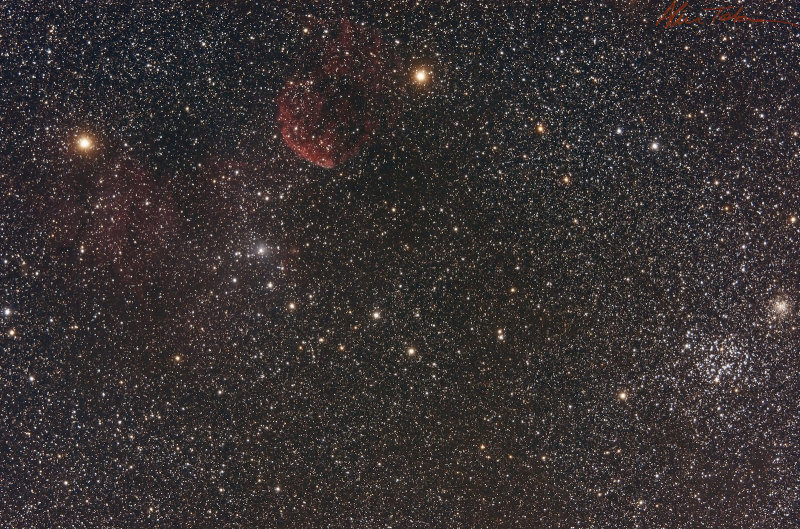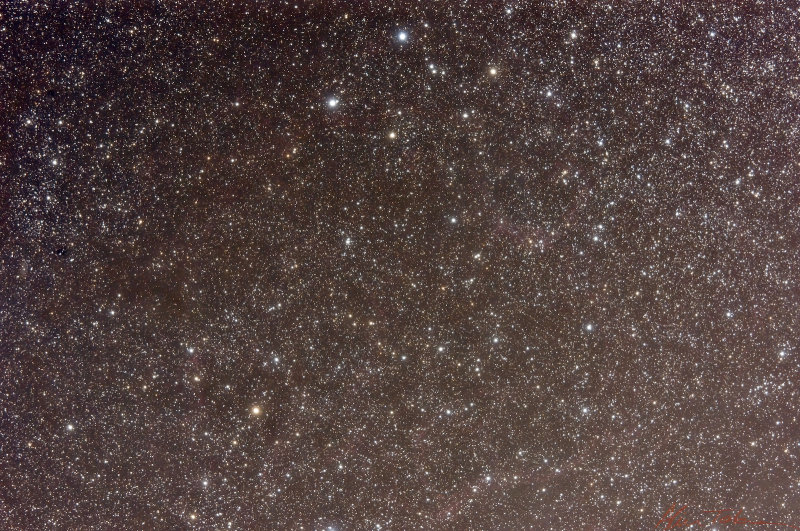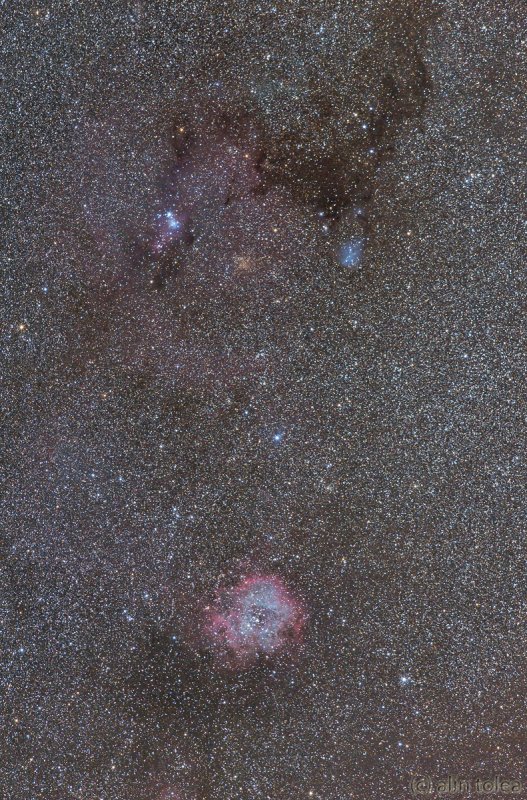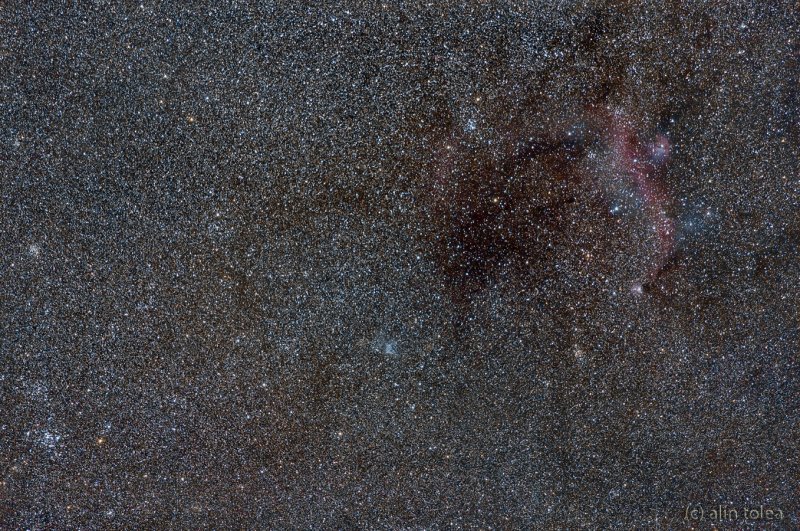24-OCT-2012

Smack between Eta and Mu Geminorum, which make up Castor's left foot (as in Castor and Pollux in Gemini) we find a lot of deep sky objects.
M35 (and the smaller NGC 2158) are the two open clusters to the right of the frame. Such a lovely sight through any telescope!
IC443 is the jellyfish like red nebula on the top of the image. It's actually nicknamed Jellyfish nebula! It's a "planetary" nebula, just (mostly) atomic Hydrogen gas ejected and pushed around by the intense stellar winds of a star in a Red Giant phase. The star is long dead now, with it's superdense core left as a White Dwarf, hot and emitting a lot of UV light, which in turns makes the gas glow..
IC444 is the red diffuse glow center left in the image. There's a small reflection nebula smack in the middle there (the diffuse "star"), but it's late and I don't feel like looking up what it is.
There's a lot of brown dust permeating the bottom part of the image too.
Wanna see a better shot? Phillip Perkins of AstroCruise has a good LRGB version of this:
http://www.astrocruise.com/milky_way/ic443-444_0902.htm
I think I got the dust better than he did though! Well, at least till Rogelio tries this one (though I have a feeling he already did).
1h 18 minutes of exposure (8 subs) , Canon 5D MK III at ISO 1600, Borg 77 ED II + Borg 0.85x reducer. I love this little telescope. This is my final shot from the little October 2012 astrophoto expedition at Mountain Meadows, WV. Just lovely.
23-OCT-2012
California Nebula - NGC 1499
Now this is my first real nice photo or a real nice object!
A few degree North of Pleiades, and I could swear I can see it in 10x50 binoculars that night in WV.
1 h, 9 minutes with a 5D MK III at ISO 1600, Borg 77 ED II + Borg 0.85x reducer.
Deep Sky Stacker + Nebulosity for preprocessing (DSS has issues with image registration) and Pixinsight. Aperture to add the watermark and to boost the color a bit. As if it needed it...
22-OCT-2012

Simeis - 147 . Or something like that..
Right.
This is the result of 2h and 19 minutes of exposure (14 subs), from a very dark site in West Virginia, under exceptional skies. And some wizardry in Pixinsight, I couldn't see _anything_ on the individual 10 min subs. Nothing. This is a _long_ exposure, with a very good consumer DSLR. Most of my exposures elsewhere on this page are 30 mins total!
5D MK III, ISO 1600, Borg 77 ED II refractor + 0.85x DG-L reducer.
Besides covering only about a quarter of Rogelio's image, the DSRL doesn't hold a candle to a CCD + H alpha filter...
But at least I got something. You can clearly see wispy red filaments and loops permeating the image, and they're for real. Don't believe me? Look at Rogelio's picture :).
For those of you who find all this to be some sort of mambo-jumbo, this is a picture of a very small area on the sky. All the points are stars in our own Galaxy, the Milky Way. The red filamentary stuff is hydrogen gas
pushed around by an ancient supernova explosion.. Same explosion heated the gas and made it glow..
Enjoy!
July 27 2011
While this is still not good enough, it's a progress compared to my previous attempt at processing a Veil Nebula shot, and really my first Veil Nebula entirely shot/processed by me.
In short, it's a redo of the picture CIlian took at Vladeasa 2009 camp, but this is mine :D. Approximately 1h exposure, 20x3 minute subs at ISO 1600 with the same equipment as the previous Veil attempt, Canon 5D MK II, Canon 200 f:2.8 EF ED telephoto lens, closed at F:4. Well maybe not the same camera, since now it's IR enhanced, the original filter was replaced with a Baader IR/UV filter for better H alpha throughput. Not sure if I see a difference though!
Processed with DSS and Pixinsight 1.7, no photoshop this time. The only different thing I did at the very end was to slightly bias the 128 pixel wavelet, which enhanced the large scale structure. Does it look weird now? You tell me.
Enjoy
Feb 14, 2010
This is a widefield shot of part of the constellation Orion.
In the lower right (SW) corner of the image we find the Great Orion Nebula (M42/M43, center right we find the Zeta orionis nebula (sort of orange and x-crossed by dark lanes) and the pink Flame Nebula with the dark silhouette of the HorseHead Nebula superimposed.
Occupying the entire left (East) half of the image we find part of the enormous Barnard's Loop, thought to be the product of many supernovae explosions in the Orion Nebula Complex.
Top/center of the image we also find the reflection nebula M78, also crossed by a dark lane.
Brown dust and dark dust lanes fill the space in between M42 and M78 and even beyond.
Like most images on this page, this is a work in progress...
February 2009

In short, this is a picture of small part of the sky. I placed the camera outfitted with a telephoto lens on a mount which compensates for the Earth's rotation, opened the shutter and exposed for 5 minutes. Took 5 of these, and co-added and post processed the final image (remove noise, saturate colors) using specialized software.
The long story:
From a light polluted site, Monoceros is a barren wasteland. Darker sites give life to this area of the sky, with the faint glow of the Winter Mily Way filling the area east of Orion.
The area is filled with Deep Sky objects. To the bottom of the image, the magnificent Rosette Nebula (NGC 2237-39.46), an HII region forming stars. The star cluster in the center of the nebula is NGC224, formed in the very "heart" of the nebula and making it "glow" by bombarding it with UV photons.
I've seen the Rosette more or less how it's visible here from the Winter Star Party in 2009 (where this picture is also taken), using my 14" Dobsonian, a WO 28mm UWAN eyepiece and Astronomik 2" OIII filter. The combination gave me enough field to make out the outline of the nebula. I've seen it many other times from places with worse skies and far smaller scopes (even glimpsed in binoculars), but you need a big scope and a wide view if you want to see it better. According to the late Walter Scott Houston, a dark sky and a nebula filter held to your eye is enough to glimpse it. I tried that several times, but never managed to see it. Maybe my skies were never dark enough.
To the top/left of the image (N) lies NGC 2264, an emission/reflection nebular complex better know as the backdrop of a small dark nebula called the Cone Nebula. The Cone is very small and barely discernible to the SSE of the main emission complex, just below a yellow star.
Top/right of the image we find IC 2169, a reflection nebula (Dreyer's Nebula?), with a few dust-lanes superimposed on it.
Between IC2169 and NGC 2266, and faintly connected to NGC2264 you can see a a large diffuse emission nebula. The whole complex is the "tip" of the same huge mollecular cloud. Read here:
http://www.atlasoftheuniverse.com/nebulae/ngc2264.html , if you'd like more detail about the region..
To the top of IC2169 one can notice three "fuzzy" stars, they're reflection nebulae surrounding three stars embedded in the mollecular cloud. From left to right (E to W), NGC 2247, NGC 2245 and IC 446.
To the top center of the image lies Trumpler 5, a distant (3 kpc), large (20 pc), old (the stars are all old red supergiants) and very massive (3000 solar mases) open clusters in the Galaxy! For comparison, Rosette nebula (at the bottom of the frame) is also abotu 20 pc diameter and situated at 1.6 kpc. Hmm, maybe not the best comparison. See
http://adsabs.harvard.edu/cgi-bin/bib_query?1998A&AS..133...25K for details about Trumpler 5.
Ah, and just peaking over the edge of the image, to the very bottom, is what I think it's a part of the emission nebula Shapeless 2-282!
Light pollution from nearby Pine Key can be seen in the bottom right (SW) corner of the image. I think.
2/16/2010

This a medium angle view (7x10 degrees) of the Winter Milky Way just East of Sirius, Alpha Canis Majoris, the brightest star on the Earth's sky after the Sun. Sirius itself is not in the picture.
Many Deep Sky Objects are present in the picture, including the long streaming red emission nebula IC2177 = Seagull Nebula to the right of the image, the little circular emission nebula Gum 1 (top right, to the right of IC2177), the small emission/reflection nebular complex Ced 90 to South of Seagull Nebula, and Thor's Helmet = NGC 2359, the incredibly beautiful reflection nebula center right of the image. Thor's Helmet is actually an interstellar bubble in a massive molecular cloud, blown away by the very intense and violent stellar wind of the Wolf-Rayet star HD56925, embedded in the image of the nebula.
Large and small dark nebulae fill the view, along with many, many open clusters, most notable Messier 47 to the East (left) of the image. I know, I missed M46, I wanted to include it, but framing was not easy. Every single star in this image is a star in our own Galaxy, the Milky Way.
7x5 minutes frames @ ISO 1600, Canon 5D Mark II, Canon 200mm F:2.8 II ED EF lens, on Astrotrac TT320X, shot from a not so great site in Antigua, just south of Hawksbill resort, beyond the fence to the nude beach :D, on Feb 16 2010. SQM measurement was 20.40 in the area, moderate light pollution, but I got lucky with the latitude, at 17N, the thing was riding high in the sky.
Deep Sky Stacker, Pixinsight 1.5.9 and Photoshop CS4. And lots of unslept nights. Enjoy.
PS
This guy is the real thing.
Veil Nebula as photographed from the Vladeasa Cabin in Bihor-Vladeasa Mountains, August 2009, during the Transilvania Star Party - Vladeasa 2009.
For this shot, Cilian Andres painstakingly took 11x5 minutes images, using a 5D Mark II at ISO 1600, through a Canon 200mm f:2.8 lens, riding on a Astrotrac TT 320X mount. Alin Tolea later coadded the images using the freeware package Deep Sky Stacker 3.3.0 and further enhanced the resulting image in Pixinsight 1.5.2 and Photoshop CS3.
As a funny aside, Cilian's car slipped and hit another parked car at the cabin while he was exposing. After he was notified, he quickly inspected the damage, arranged for a joint trip to the insurance agency the next day and returned to the camera. It was at ~ 3 am in the morning. That's what I call dedication.
2/25/2009
This is the Gum Nebula and Vela Supernova Remnant shot at the Winter Star Party 2009 with a 200mm f:2.8 Canon EF @ f:2.8, ISO 2000, 6x5mins, Deep Sky Stacker, Pixinsight, PS CS3.
A bit less technical now, it's a picture of a small part of the sky in the direction of the constellation Vela. The big loop/filamentary like structure, red/green, is the mark of a supernova which exploded about 14000-20000 yrs ago (depending on whom you ask). The rest of the red stuff are glowing clouds of H gas, stellar nurseries, called diffuse emission nebulae. Also, every single point in this picture is a star in our own galaxy, the Milky Way.











